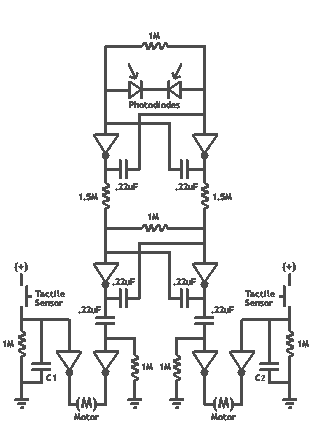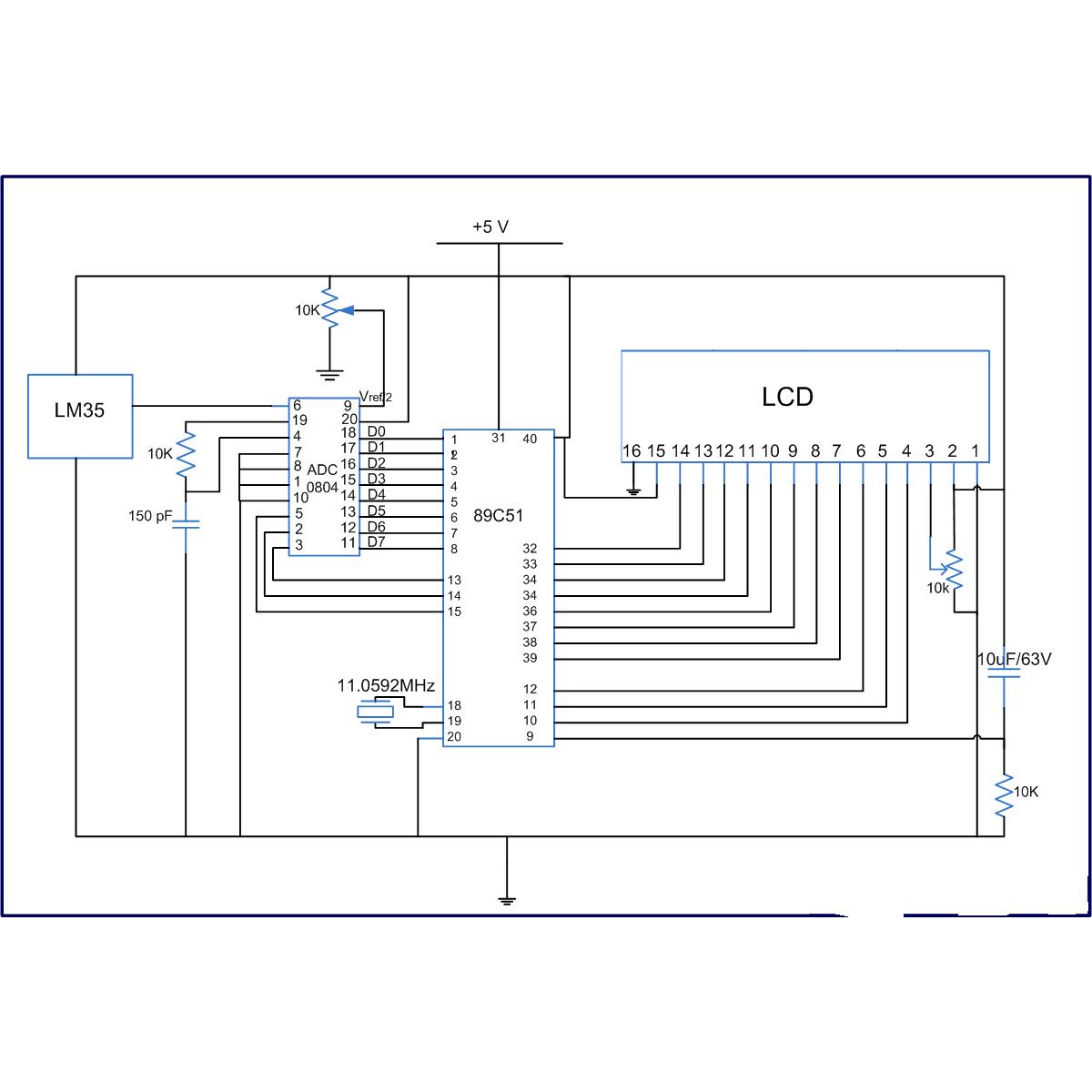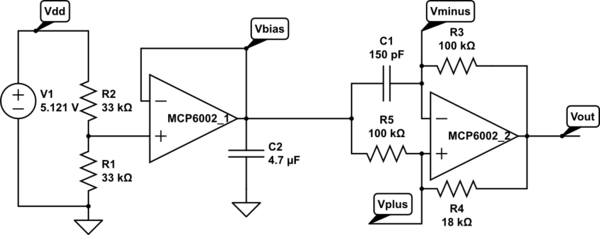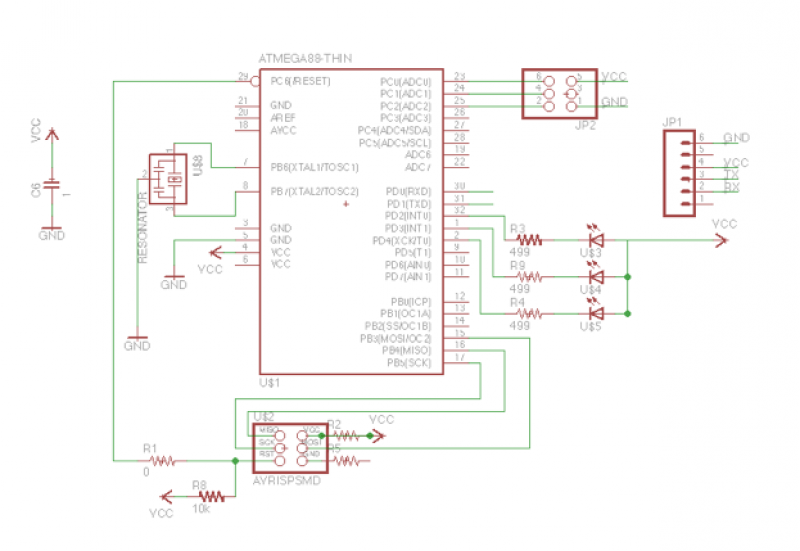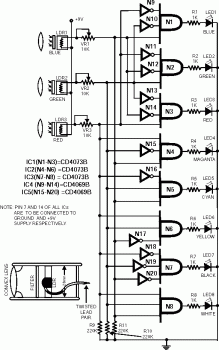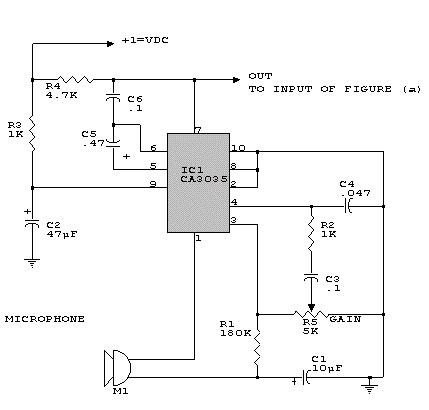
Two-Wire Temperature Sensor

Remote temperature measurements must be connected to the relevant test instrument using a cable. Typically, a three-core cable is employed: one core for the signal and two for the power supply. If a two-core cable is necessary, one of the power supply lines must be combined with the signal line. This configuration is feasible with temperature sensors such as the LM334 and LM335. However, these sensors output a signal that is directly proportional to absolute temperature, which may not always be practical. For applications requiring an output signal proportional to the Celsius temperature scale, the LM45 sensor circuit presents an effective solution. The LM45 sensor operates on an alternating voltage, while its output is a direct voltage. The sensor is powered by a sine-wave generator, which includes components A1 and A2 (refer to the diagram). The alternating voltage is transmitted to the signal line in the two-core cable through coupling capacitor C6. The sensor utilizes a voltage-doubling rectifier composed of diodes D1 and D2 along with capacitors C1 and C2 to convert the applied alternating voltage into a direct voltage. Resistor R2 serves to isolate the output from load capacitance, while choke L1 facilitates the coupling of the sensor's output signal to the cable's signal line. Choke L1 and capacitor C2 also provide protection against the alternating voltage on the line. At the receiving end of the link, the network formed by R3, L2, and C4 acts as a low-pass filter, preventing the alternating supply voltage from merging with the sensor output. Capacitor C5 blocks direct current through R3, which could otherwise attenuate the voltage that varies with temperature. The output load should maintain a high resistance, approximately 100 kΩ or greater. The circuit operates with a current draw of a few milliamperes.
The circuit design for remote temperature measurement using the LM45 sensor provides an efficient solution for applications requiring a temperature reading in degrees Celsius. The use of a two-core cable simplifies connections, especially in scenarios where space or weight constraints are critical. The sine-wave generator, comprising A1 and A2, serves as the power source, ensuring a stable alternating voltage supply to the LM45 sensor.
The coupling capacitor C6 is crucial as it allows the alternating signal to pass while blocking any direct current components, ensuring that only the desired alternating voltage reaches the sensor. The voltage-doubling rectifier (D1-D2-C1-C2) is a vital circuit section that transforms the alternating voltage into a usable direct voltage, enabling the sensor to provide an accurate output proportional to the temperature.
Resistor R2 plays an essential role in maintaining the integrity of the output signal by isolating it from capacitive loads that could distort the temperature reading. Choke L1 is designed to effectively couple the sensor output to the signal line while filtering out any unwanted alternating voltage, thus preserving the accuracy of the temperature measurement.
At the receiving end, the low-pass filter network (R3-L2-C4) is designed to eliminate any remaining alternating voltage components that might interfere with the sensor's output. Capacitor C5 ensures that direct current does not flow through R3, which would adversely affect the temperature-dependent voltage signal.
In summary, this circuit design is well-suited for applications where remote temperature measurement is required, providing an effective means of delivering accurate temperature readings over extended distances while maintaining signal integrity and minimizing the impact of alternating voltage interference. The high output load resistance requirement further ensures that the circuit operates efficiently without drawing excessive current.Remote temperature measurements have to be linked by some sort of cable to the relevant test instrument. Normally, this is a three-core cable: one core for the signal and the other two for the supply lines.
If the link is required to be a two-core cable, one of the supply lines and the signal line have to be combined. This is possible with, for in stance, temperature sensors LM334 and LM335. However, these devices provide an output that is directly proportional to absolute temperature and this is not always a practical proposition. If an output signal that is directly proportional to the Celsius temperature scale is desired, the present circuit, which uses a Type LM45 sensor, offers a good solution.
The LM45 sensor is powered by an alternating voltage, while its output is a direct voltage. The supply to the sensor is provided by a sine-wave generator, based on A1 and A2 (see diagram). The alternating voltage is applied to the signal line in the two-core cable via coupling capacitor C6. The sensor contains a voltage-doubling rectifier formed by D1-D2-C1-C2. This network converts the applied alternating voltage into a direct voltage. Resistor R2 isolates the output from the load capacitance, while choke L1 couples the output signal of the sensor to the signal line in the cable.
Choke L1 and capacitor C2 protect the output against the alternating voltage present on the line. At the other end of the link, network R3-L2-C4 forms a low-pass section that prevents the alternating supply voltage from combining with the sensor output. Capacitor C5 prevents a direct current through R3, since this would attenuate the temperature-dependent voltage.
The output load should have a high resistance, some 100 k or even higher. The circuit draws a current of a few mA. 🔗 External reference
The circuit design for remote temperature measurement using the LM45 sensor provides an efficient solution for applications requiring a temperature reading in degrees Celsius. The use of a two-core cable simplifies connections, especially in scenarios where space or weight constraints are critical. The sine-wave generator, comprising A1 and A2, serves as the power source, ensuring a stable alternating voltage supply to the LM45 sensor.
The coupling capacitor C6 is crucial as it allows the alternating signal to pass while blocking any direct current components, ensuring that only the desired alternating voltage reaches the sensor. The voltage-doubling rectifier (D1-D2-C1-C2) is a vital circuit section that transforms the alternating voltage into a usable direct voltage, enabling the sensor to provide an accurate output proportional to the temperature.
Resistor R2 plays an essential role in maintaining the integrity of the output signal by isolating it from capacitive loads that could distort the temperature reading. Choke L1 is designed to effectively couple the sensor output to the signal line while filtering out any unwanted alternating voltage, thus preserving the accuracy of the temperature measurement.
At the receiving end, the low-pass filter network (R3-L2-C4) is designed to eliminate any remaining alternating voltage components that might interfere with the sensor's output. Capacitor C5 ensures that direct current does not flow through R3, which would adversely affect the temperature-dependent voltage signal.
In summary, this circuit design is well-suited for applications where remote temperature measurement is required, providing an effective means of delivering accurate temperature readings over extended distances while maintaining signal integrity and minimizing the impact of alternating voltage interference. The high output load resistance requirement further ensures that the circuit operates efficiently without drawing excessive current.Remote temperature measurements have to be linked by some sort of cable to the relevant test instrument. Normally, this is a three-core cable: one core for the signal and the other two for the supply lines.
If the link is required to be a two-core cable, one of the supply lines and the signal line have to be combined. This is possible with, for in stance, temperature sensors LM334 and LM335. However, these devices provide an output that is directly proportional to absolute temperature and this is not always a practical proposition. If an output signal that is directly proportional to the Celsius temperature scale is desired, the present circuit, which uses a Type LM45 sensor, offers a good solution.
The LM45 sensor is powered by an alternating voltage, while its output is a direct voltage. The supply to the sensor is provided by a sine-wave generator, based on A1 and A2 (see diagram). The alternating voltage is applied to the signal line in the two-core cable via coupling capacitor C6. The sensor contains a voltage-doubling rectifier formed by D1-D2-C1-C2. This network converts the applied alternating voltage into a direct voltage. Resistor R2 isolates the output from the load capacitance, while choke L1 couples the output signal of the sensor to the signal line in the cable.
Choke L1 and capacitor C2 protect the output against the alternating voltage present on the line. At the other end of the link, network R3-L2-C4 forms a low-pass section that prevents the alternating supply voltage from combining with the sensor output. Capacitor C5 prevents a direct current through R3, since this would attenuate the temperature-dependent voltage.
The output load should have a high resistance, some 100 k or even higher. The circuit draws a current of a few mA. 🔗 External reference
